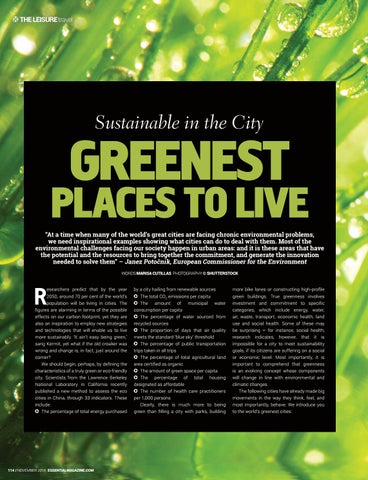h THE LEISURE travel
Sustainable in the City
Greenest
Places to Live “At a time when many of the world’s great cities are facing chronic environmental problems, we need inspirational examples showing what cities can do to deal with them. Most of the environmental challenges facing our society happen in urban areas: and it is these areas that have the potential and the resources to bring together the commitment, and generate the innovation needed to solve them” – Janez Potočnik, European Commissioner for the Environment WORDS Marisa cutillas photography © Shutterstock
R
esearchers predict that by the year 2050, around 70 per cent of the world’s population will be living in cities. The figures are alarming in terms of the possible effects on our carbon footprint, yet they are also an inspiration to employ new strategies and technologies that will enable us to live more sustainably. ‘It ain’t easy being green,’ sang Kermit, yet what if the old croaker was wrong and change is, in fact, just around the corner? We should begin, perhaps, by defining the characteristics of a truly green or eco-friendly city. Scientists from the Lawrence Berkeley National Laboratory in California recently published a new method to assess the eco cities in China, through 33 indicators. These include: ZZ The percentage of total energy purchased
by a city hailing from renewable sources ZZ The total CO2 emissions per capita ZZ The amount of municipal water consumption per capita ZZ The percentage of water sourced from recycled sources ZZ The proportion of days that air quality meets the standard ‘blue sky’ threshold ZZ The percentage of public transportation trips taken in all trips ZZ The percentage of total agricultural land area certified as organic ZZ The amount of green space per capita ZZ The percentage of total housing designated as affordable ZZ The number of health care practitioners per 1,000 persons Clearly, there is much more to being green than filling a city with parks, building
more bike lanes or constructing high-profile green buildings. True greenness involves investment and commitment to specific categories, which include energy, water, air, waste, transport, economic health, land use and social health. Some of these may be surprising – for instance, social health; research indicates, however, that it is impossible for a city to meet sustainability goals, if its citizens are suffering on a social or economic level. Most importantly, it is important to comprehend that greenness is an evolving concept whose components will change in line with environmental and climatic changes. The following cities have already made big movements in the way they think, feel, and most importantly, behave. We introduce you to the world’s greenest cities:
114 / NOVEMBER 2016 ESSENTIALMAGAZINE.COM
207 TrI.indd 114
10/24/16 11:50 AM
